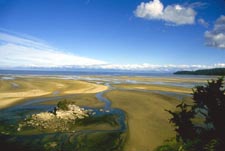| Tides
 Tides
are the vertical rising and lowering of sea level, and are greatly controlled
by the gravitational pull of the sun and moon. Although the sun has a stronger
gravitational attraction than the moon, the moon's relative nearness to
the earth makes its gravitational pull more than twice as effective as
the sun's. Tides
are the vertical rising and lowering of sea level, and are greatly controlled
by the gravitational pull of the sun and moon. Although the sun has a stronger
gravitational attraction than the moon, the moon's relative nearness to
the earth makes its gravitational pull more than twice as effective as
the sun's.
What Does the Pull of the Moon
Do to the Oceans?
The gravitational pull of the moon creates two types
of tides: high and low. A tidal bulge occurs in the oceans on the side
of the earth nearest the moon; a second tidal bulge occurs on the far side
of the earth. These bulges are high tides. The areas between the tidal
bulges experience low tide. Usually two high and two low tides occur each
24 hours and 50 minutes.

Spring Tides And Neap Tides
When the moon is full or new, the gravitational pull
of the moon and sun are combined. At these times,the high tides are very
high and the low tides are very low. This is known as a spring high tide.
During the moon's quarterphases the sun and moon work at
right angles, causing the bulges to cancel each other. The result is a
smaller difference between high and low tides and is known as a neap tide.
Tides Around The World
Tidal changes are different in various parts of the world.
Near the equator, there is very little noticeable change because a large
volume of water is spread out over a wide range.
The highest tides in the world are at the Bay of Fundy
in Nova Scotia. The bay is very narrow, so water rushing in from the ocean
can rise and fall up to 20 meters a day!
Try a Tide Activity!
| Disclaimer |
Copyright © 2002 Missouri
Botanical Garden
|
 |
| 
